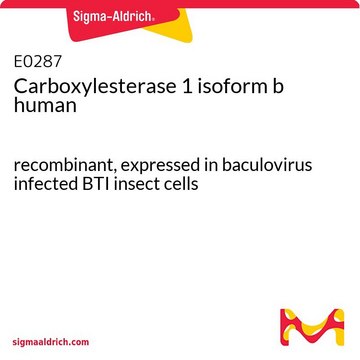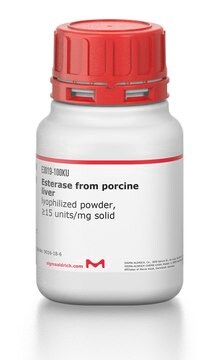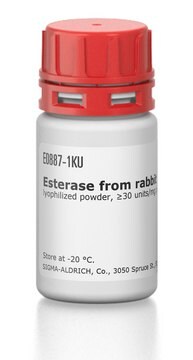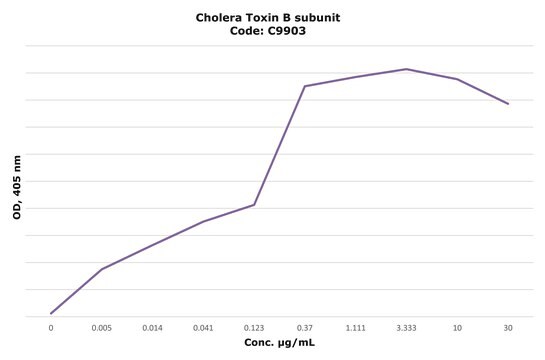E0412
Carboxylesterase 2 human
recombinant, expressed in baculovirus infected BTI insect cells
Sinónimos:
Carboxylesterase 2 human, CES2, CES2A1
Iniciar sesiónpara Ver la Fijación de precios por contrato y de la organización
About This Item
Productos recomendados
recombinante
expressed in baculovirus infected BTI insect cells
Nivel de calidad
Formulario
liquid
actividad específica
≥500 units/mg protein
mol peso
60 kDa
peso
(0.5 ml)
Condiciones de envío
dry ice
temp. de almacenamiento
−70°C
¿Está buscando productos similares? Visita Guía de comparación de productos
Descripción general
Carboxylesterase 2 human gene is mapped to human chromosome 16q22.1.
Carboxylesterase belongs to the α/β hydrolase fold family and is involved in drug metabolism and activation. It is present in colon, liver, small intestine, heart, brain and testis. The hydrolase activity of small intestine is attributed to carboxylesterase 2 human. It has two glycosylation sites at 103 and 267 residues with molecular mass 60kDa.
Aplicación
Carboxylesterase 2 human has been used:
- in the in vitro enzyme-based inhibitor screening assay
- in substrate selectivity assay with emission ratiometric two-photon probe (SE1)
- as a reference standard in the enzyme assay with various 4-nitrophenyl and 1-naphthyl based substrates
Carboxylesterase 2 may play a key role in biotransformation of a variety of ester containing drugs and prodrugs.
Delivers high catalytic activity, ideal for robust high-throughput screening assays including drug-drug interaction studies, and pharmacokinetic studies for evaluating pro-drugs and non-CYP pathways of elimination.
Acciones bioquímicas o fisiológicas
Carboxylesterase 2 human identifies the site containing a large alcohol and small acyl group. It shows less transesterification activity due to presence of conformational interference in active site.
Member of a serine esterase family that hydrolyze ester and amide bonds. Carboxylesterase 2 is an endoplasmic reticulum-bound hydrolase that plays a critical role in xenobiotic detoxification and activation for ester-containing therapeutics. Carboxylesterase 2 is also involved in the detoxification of drugs such as heroin and cocaine. This enzyme is thought to play a role in lipid metabolism.
Definición de unidad
One unit will produce 1 nanomole of 4-nitrophenol from 4-nitrophenyl acetate per minute at pH 7.4 at 37 deg C.
Código de clase de almacenamiento
10 - Combustible liquids
Clase de riesgo para el agua (WGK)
nwg
Punto de inflamabilidad (°F)
Not applicable
Punto de inflamabilidad (°C)
Not applicable
Elija entre una de las versiones más recientes:
¿Ya tiene este producto?
Encuentre la documentación para los productos que ha comprado recientemente en la Biblioteca de documentos.
Los clientes también vieron
Human liver carboxylesterase. Purification and molecular properties.
W Junge et al.
Archives of biochemistry and biophysics, 165(2), 749-763 (1974-12-01)
T Satoh et al.
Annual review of pharmacology and toxicology, 38, 257-288 (1998-05-23)
Multiple carboxylesterases (EC 3.1.1.1) play an important role in the hydrolytic biotransformation of a vast number of structurally diverse drugs. These enzymes are major determinants of the pharmacokinetic behavior of most therapeutic agents containing ester or amide bonds. Carboxylesterase activity
Tetsuo Satoh et al.
Drug metabolism and disposition: the biological fate of chemicals, 30(5), 488-493 (2002-04-16)
This article reports on a symposium sponsored by the American Society for Pharmacology and Experimental Therapeutics and held at the April 2001 Experimental Biology meeting. Current developments in molecular-based studies into the structure and function of cholinesterases, carboxylesterases, and paraoxonases
Teruko Imai
Drug metabolism and pharmacokinetics, 21(3), 173-185 (2006-07-22)
Human carboxylesterase 1 (hCE-1, CES1A1, HU1) and carboxylesterase 2 (hCE-2, hiCE, HU3) are a serine esterase involved in both drug metabolism and activation. Although both hCE-1 and hCE-2 are present in several organs, the hydrolase activity of liver and small
Jianqin Zhang et al.
Chemosphere, 93(6), 1207-1215 (2013-08-01)
Carboxylesterases (CarEs) play key roles in metabolism of specific hormones and detoxification of dietary and environmental xenobiotics in insects. We sequenced and characterized CarE cDNAs putatively derived from two different genes named LmCesA1 and LmCesA2 from the migratory locust, Locusta
Nuestro equipo de científicos tiene experiencia en todas las áreas de investigación: Ciencias de la vida, Ciencia de los materiales, Síntesis química, Cromatografía, Analítica y muchas otras.
Póngase en contacto con el Servicio técnico









